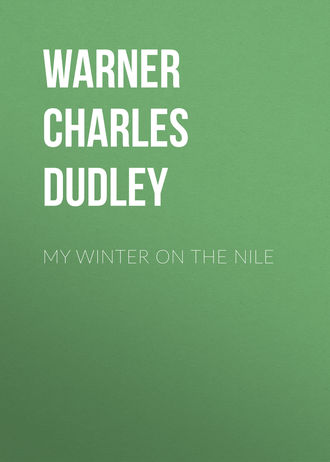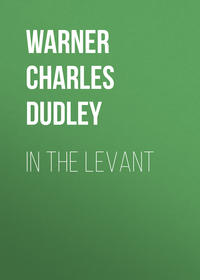 полная версия
полная версияMy Winter on the Nile
We hear now a chanting down the dusky street. Somebody is being carried to his tomb in the desert outside the city. The procession has to squeeze through the crowd. First come a half dozen old men, ragged and half blind, harbingers of death, who move slowly, crying in a whining tone, “There is no deity but God; Mohammed is God’s apostle; God bless and save him.” Then come two or three schoolboys singing in a more lively air verses of a funeral hymn. The bier is borne by friends of the deceased, who are relieved occasionally by casual passengers. On the bier, swathed in grave-clothes, lies the body, with a Cashmere shawl thrown over it. It is followed by female hired mourners, who beat their breasts and howl with shrill and prolonged ululations. The rear is brought up by the female mourners, relations—a group of a dozen in this case—whose hair is dishevelled and who are crying and shrieking with a perfect abandonment to the luxury of grief. Passengers in the street stop and say, “God is most great,” and the women point to the bier and say, “I testify that there is no deity but God.”
When the funeral has passed and its incongruous mingling of chanting and shrieking dies away, we turn towards the gold bazaar. All the goldsmiths and silversmiths are Copts; throughout Egypt the working of the precious metals is in their hands. Descended from the ancient Egyptians, or at least having more of the blood of the original race in them than others, they have inherited the traditional skill of the ancient workers in these metals. They reproduce the old jewelry, the barbarous ornaments, and work by the same rude methods, producing sometimes the finest work with the most clumsy tools.
The gold-bazaar is the narrowest passage we have seen. We step down into its twilight from a broader street. It is in fact about three feet wide, a lane with an uneven floor of earth, often slippery. On each side are the little shops, just large enough for the dealer and his iron safe, or for a tiny forge, bellows and anvil. Two people have to make way for each other in squeezing along this alley, and if a donkey comes through he monopolizes the way and the passengers have to climb upon the mastabahs either side. The mastabah is a raised seat of stone or brick, built against the front of the shop and level with its floor, say two feet and a half high and two feet broad. The lower shutter of the shop turns down upon the mastabah and forms a seat upon which a rug is spread. The shopkeeper may sit upon this, or withdraw into his shop to make room for customers, who remove their shoes before drawing up their feet upon the carpet. Sometimes three or four persons will crowd into this box called a shop. The bazaar is a noisy as well as a crowded place, for to the buzz of talk and the cries of the itinerant venders is added the clang of the goldsmiths’ hammers; it winds down into the recesses of decaying houses and emerges in another direction.
We are to have manufactured a bracelet of gold of a pattern as old as the Pharaohs, and made with the same instruments that the cunning goldsmiths used three thousand years ago. While we are seated and bargaining for the work, the goldsmith unlocks his safe and shows us necklaces, bracelets, anklets, and earrings in the very forms, bizarre but graceful, of the jewelry of which the Israelites spoiled the Egyptian women. We see just such in the Museum at Boulak; though these are not so fine as the magnificent jewelry which Queen Aah-hotep, the mother of Amosis, attempted to carry with her into the under-world, and which the scientific violators of her tomb rescued at Thebes.
In the shop opposite to us are squeezed in three Egyptian women and a baby, who have come to spend the day in cheapening some bit of jewelry. There is apparently nothing that the Cairo women like so much as shopping—at least those who are permitted to go out at all—and they eke out its delights by consuming a day or two in buying one article. These women are taking the trade leisurely, examining slowly and carefully the whole stock of the goldsmith and deliberating on each bead and drop of a necklace, glancing slily at us and the passers-by out of their dark eyes meantime. They have brought cakes of bread for lunch, and the baby is publicly fed as often as he desires. These women have the power of sitting still in one spot for hours, squatting with perfect patience in a posture that would give a western woman the cramp for her lifetime. We are an hour in bargaining with the goldsmith, and are to return late in the afternoon and see the bracelet made before our eyes, for no one is expected to trust his fellow here.
Thus far the gold has only been melted into an ingot, and that with many precautions against fraud. I first count out the napoleons of which the bracelet is to be made. These are weighed. A fire is then kindled in the little forge, the crucible heated, and I drop the napoleons into it, one by one. We all carefully watch the melting to be sure that no gold is spilled in the charcoal and no base metal added. The melted mass is then run into an ingot, and the ingot is weighed against the same number of napoleons that compose it. And I carry away the ingot.
When we return the women are still squatting in the shop in the attitude of the morning. They show neither impatience nor weariness; nor does the shopkeeper. The baby is sprawled out in his brown loveliness, and the purchase of a barbarous necklace of beads is about concluded. Our goldsmith now removes his outer garment, revealing his fine gown of striped silk, pushes up his sleeves and prepares for work. His only-tools are a small anvil, a hammer and a pair of pincers. The ingot is heated and hammered, and heated and hammered, until it is drawn out into an even, thick wire. This is then folded in three to the required length, and twisted, till the gold looks like molasses candy; the ends are then hammered together, and the bracelet is bent to its form. Finally it is weighed again and cleaned. If the owner wishes he can have put on it the government stamp. Gold ornaments that are stamped, the goldsmith will take back at any time and give for them their weight in coin, less two per cent.
On our way home we encounter a wedding procession; this is the procession conducting the bride to the house of the bridegroom; that to the bath having taken place two days before. The night of the day before going to the bridegroom is called the “Night of henna.” The bride has an entertainment at her own house, receives presents of money, and has her hands and her feet dyed with henna. The going to the bridegroom is on the eve of either Monday or Friday. These processions we often meet in the streets of Cairo; they wander about circuitously through the town making all the noise and display possible. The procession is a rambling affair and generally attended by a rabble of boys and men.
This one is preceded by half a dozen shabbily dressed musicians beating different sorts of drums and blowing hautboys, each instrument on its own hook; the tune, if there was one, has become discouraged, and the melody has dropped out; thump, pound, squeak, the music is more disorganized than the procession, and draggles on in noisy dissonance like a drunken militia band at the end of a day’s “general training.”
Next come some veiled women in black; and following them are several small virgins in white. The bride walks next, with a woman each side of her to direct her steps. This is necessary, for she is covered from head to feet with a red cashmere shawl hanging from a sort of crown on the the top of her head. She is in appearance, simply a red cone. Over her and on three sides of her, but open in front, is a canopy of pink silk, borne on poles by four men. Behind straggle more musicians, piping and thumping in an independent nonchalance, followed by gleeful boys. One attendant sprinkles rose-water on the spectators, and two or three others seem to have a general direction of the course of the train, and ask backsheesh for it whenever a stranger is met.
The procession gets tired occasionally and sits down in the dust of the road to rest. Sometimes it is accompanied by dancers and other performers to amuse the crowd. I saw one yesterday which had halted by the roadside, all the women except the bride squatting down in patient resignation. In a hollow square of spectators, in front, a male dancer was exhibiting his steps. Holding a wand perpendicularly before him with both hands, he moved backwards and forwards, with a mincing gait, exhibiting neither grace nor agility, but looking around with the most conceited expression I ever saw on a human face. Occasionally he would look down at his legs with the most approving glance, as much as to say, “I trust, God being great, that you are taking particular notice of those legs; it seems to me that they couldn’t be improved.” The fellow enjoyed his dancing if no one else did, and it was impossible to get him to desist and let the procession move on. At last the cortege made a detour round the man who seemed to be so popular with himself, and left him to enjoy his own performance.
Sometimes the expense of this zeffeh, or bridal procession, is shared by two parties, and I have seen two brides walking under the same canopy, but going to different husbands. The public is not excluded from an interest in these weddings. The house of a bridegroom, near the Mooskee, was illuminated a night or two before the wedding, colored lanterns were hung across the street, and story-tellers were engaged to recite in front of the house. On the night of the marriage there was a crowd which greatly enjoyed the indelicate songs and stories of the hired performers. Late in the evening an old woman appeared at a window and proclaimed that the husband was contented with his wife.
An accompaniment of a bridal procession which we sometimes saw we could not understand. Before the procession proper, walked another, preceded by a man carrying on his head a high wooden cabinet, with four legs, the front covered with pieces of looking-glass and bits of brass; behind him were musicians and attendants, followed by a boy on horseback, dressed richly in clothes too large for him and like a girl’s. It turned out to be a parade before circumcision, the friends of the lad having taken advantage of the bridal ceremony of a neighbor to make a display. The wooden case was merely the sign of the barber who walked in the procession and was to perform the operation.
“I suppose you are married?” I ask Hadji when the procession has gone by.
“Yes, sir, long time.”
“And you have never had but one wife?”
“Have one. He quite nuff for me.”
“How old was she when you married her?”
“Oh, I marry he, when he much girl! I tink he eleven, maybe twelve, not more I tink.”
Girls in Egypt are marriageable at ten or eleven, and it is said that if not married before they are fourteen they have an excellent chance of being old maids. Precocious to mature, they are quick to fall away and lose their beauty; the laboring classes especially are ugly and flabby before eighteen. The low mental, not to say physical, condition of Egyptian women is no doubt largely due to these early marriages. The girl is married and is a mother before she has an opportunity to educate herself or to learn the duties of wife or mother, ignorant of how to make a home pleasant and even of housekeeping, and when she is utterly unfit to have the care and training of a child. Ignorant and foolish, and, as Mr. Lane says, passionate, women and mothers can never produce a great race. And the only reform for Egypt that will give it new vitality and a place in the world must begin with the women.
The Khedive, who either has foresight or listens to good advice, issued a firman some years ago forbidding the marriage of girls under fifteen. It does not seem to be respected either in city or country; though I believe that it has some influence in the city, and generally girls are not married so young in Cairo as in the country. Yet I heard recently in this city of a man of sixty who took a wife of twelve. As this was not his first wife, it could not be said of him, as it is said of some great geniuses, that he struck twelve the first time.
CHAPTER VI.—MOSQUES AND TOMBS
WHAT we in Cairo like most to do, is to do nothing in the charming winter weather—to postpone the regular and necessary sight-seeing to that limbo to which the Arabs relegate everything—bookra, that is, tomorrow. Why not as well go to the Pyramids or to Heliopolis or to the tombs of the Memlooks tomorrow! It is to be the same fair weather; we never plan an excursion, with the proviso, “If it does not rain.” This calm certainty of a clear sky adds twenty-five per cent, to the value of life.
And yet, there is the Sirocco; that enervating, depressing south wind, when all the sands of the hot desert rise up into the air and envelope everything in grit and gloom. I have been on the Citadel terrace when the city was only dimly outlined in the thick air, and all the horizon and the sky were veiled in dust as if by a black Scotch mist. We once waited three days after we had set a time to visit the Pyramids, for the air to clear. The Sirocco is bad enough in the town, the fine dust penetrates the closed recesses of all apartments; but outside the city it is unbearable. Indeed any wind raises the sand disagreeably; and dust is the great plague of Egypt. The streets of Cairo, except those that are sprinkled, are seldom free from clouds of it. And it is an ancient dust. I suppose the powdered dead of thousands of years are blowing about in the air.
The desert makes itself apparent even in Cairo. Not only is it in the air, but it lies in wait close to the walls and houses, ready to enter at the gates, sifting in through every crevice. Only by constant irrigation can it be driven back. As soon as we pass beyond the compact city eastward, we enter the desert, unless we follow the course of some refreshing canal. The drive upon it is a favorite one on summer nights. I have spoken of the desert as hot; but it is always cool at night; and it is the habit of foreigners who are detained in Cairo in the summer to go every night to the desert to cool off.
The most conspicuous object in Cairo, from all points, is the Citadel, built on a bold spur of the Mokattam range, and the adjoining Mosque of Mohammed Ali in which that savage old reformer is buried. The mosque is rather Turkish than Saracenic, and its two slender minarets are much criticised. You who have been in Constantinople are familiar with the like slight and graceful forms in that city; they certainly are not so rich or elegant as many of the elaborately carved and more robust minarets of Cairo which the genius of the old architects reared in the sun-burst of Saracenic architecture; but they are very picturesque and effective in their position and especially against a poetic evening sky.
When Salah-e’-deen robbed the pyramids to build the Citadel, he doubtless thought he was erecting a fortification that would forever protect his city and be an enduring home for the Sultans of Egypt. But Mohammed Ali made it untenable as a fort by placing a commanding battery on the Mokattam ledge; and now the Citadel (by which I mean all the group of buildings) useless as a fort (except to overawe the city) and abandoned as a palace, is little more than a ghost-walk of former splendors. There are barracks in it; recruits are drilling in its squares; the minister-of-war occupies some of its stately apartments; the American General Stone, the chief officer of the Khedive’s army, uses others; in some we find the printing presses and the bureaus of the engineers and the typographical corps; but vast halls and chambers of audience, and suites of apartments of the harem, richly carved and gilded, are now vacant and echo the footsteps of sentries and servitors. And they have the shabby look of most Eastern architecture when its first freshness is gone.
We sat in the room and on the platform where Mohammed Ali sat when the slaughter of the Memlooks was going on; he sat motionless, so it is reported, and gave no other sign of nervousness than the twisting of a piece of paper in his hands. And yet he must have heard the cries under his window, and, of course, the shots of the soldiers on the walls who were executing his orders. We looked down from the balcony into the narrow, walled lane, with its closed gates, in which the five hundred Memlooks were hemmed in and massacred. Think of the nerve of the old Turk, sitting still without changing countenance while five hundred, or more, gallant swash-bucklers were being shot in cool blood under his window! Probably he would not have been so impassive if he had seen one of the devoted band escape by spurring his horse through a break in the wall and take a fearful flying leap upon the rubbish below.
The world agrees to condemn this treacherous and ferocious act of Mohammed Ali and, generally, I believe, to feel grateful to him for it. Never was there a clan of men that needed exterminating so much as the Memlooks. Nothing less would have suited their peculiarities. They were merely a band of robbers, black-mailers, and freebooters, a terror to Egypt. Dislodged from actual power, they were still greatly to be dreaded, and no ruler was safe who did not obey them. The term Memlook means “a white male slave,” and is still so used. The Memlooks, who originally were mostly Circassian white slaves, climbed from the position of favorites to that of tyrants. They established a long dynasty of sultans, and their tombs yonder at the edge of the desert are among the most beautiful specimens of the Saracenic architecture. Their sovereignty was overthrown by Sultan Selim in 1517, but they remained a powerful and aristocratic band which controlled governors, corrupted even Oriental society by the introduction of monstrous vices, and oppressed the people. I suppose that in the time of the French invasion they may have been joined by bold adventurers of many nations. Egypt could have no security so long as any of them remained. It was doubtless in bad taste for Mohammed Ali to extend a friendly invitation to the Memlooks to visit him, and then murder them when they were caught in his trap; he finally died insane, and perhaps the lunacy was providentially on him at that time.
In the Citadel precincts is a hall occupied by the “parliament” of the Khedive, when it is in session; a parliament whose members are selected by the Viceroy from all over Egypt, in order that he may have information of the state of the country, but a body that has no power and certainly not so much influence in the state as the harem has. But its very assemblage is an innovation in the Orient, and it may lead in time to infinite gab, to election briberies and multitudinous legislation, the accompaniments of the highest civilization. We may yet live to see a member of it rise to enquire into the expenses of the Khedive’s numerous family.
The great Mosque of Mohammed Ali is in the best repair and is the least frequented of any in Cairo. Its vast, domed interior, rich in materials and ambitious in design, is impressive, but this, like all other great mosques, strikes the Western man as empty. On the floor are beautiful rugs; a tawdry chandelier hangs in the center, and the great spaces are strung with lanterns. No one was performing ablution at the handsome fountain in the marble-paved court; only a single worshipper was kneeling at prayer in all the edifice. But I heard a bird singing sweetly in the airy height of the dome.
The view from the terrace of the mosque is the finest in Egypt, not perhaps in extent, but certainly in variety and objects of interest; and if the atmosphere and the light are both favorable, it is the most poetic. From it you command not only the city and a long sweep of the Nile, with fields of living green and dark lines of palms, but the ruins and pyramids of slumberous old Memphis, and, amid the yellow sands and backed by the desolate Libyan hills, the dreamy pyramids of Geezeh. We are advised to get this view at sunset, because then the light is soft and all the vast landscape has color. This is good advice so far as the city at our feet is concerned, with its hundreds of minarets and its wide expanse of flat roofs, palm-tops and open squares; there is the best light then also on the purple Mokattam hills; and the tombs of the Memlooks, north of the cemetery, with their fairy domes and exquisite minarets and the encompassing grey desert, the whole bathed in violet light, have a beauty that will linger with one who has once seen them forever. But looking beyond the Nile, you have the sun in your face. I should earnestly entreat the stranger to take this view at sunrise. I never saw it myself at that hour, being always otherwise engaged, but I am certain that the Pyramids and the Libyan desert would wake at early morning in a glow of transcendent beauty.
We drive out the gate or Bab e’ Nasr beyond the desolate Moslem cemetery, to go to the tombs of the Circassian Memlook Sultans. We pass round and amid hills of rubbish, dirt, and broken pottery, the dumpings of the city for centuries, and travel a road so sandy that the horses can scarcely drag the heavy carriage through it. The public horses of Cairo are sorry beasts and only need a slight excuse for stopping at any time. There is nothing agreeable about the great Moslem cemetery; it is a field of sand-heaps, thickly dotted with little oven-shaped stucco tombs. They may be pleasanter below ground; for the vault into which the body is put, without a coffin, is high enough to permit its occupant to sit up, which he is obliged to do, whether he is able to sit up or not, the first night of his stay there, in order to answer the questions of two angels who come to examine him on his religious practices and views.
The Tombs of the Sultans, which are in the desert, are in fact vast structures,—tombs and mosques united—and are built of parti-colored stone. They are remarkable for the beautiful and varied forms of their minarets and for their aërial domes; the latter are covered with the most wonderful arabesque carving and tracing. They stand deserted, with the sand drifting about them, and falling to rapid decay. In the interiors are still traces of exquisite carving and color, but much of the ornamentation, being of stucco on rude wooden frames, only adds to the appearance of decay. The decay of finery is never respectable.
It is not correct, however, to speak of these mosque-tombs as deserted. Into all of them have crept families of the poor or of the vicious. And the business of the occupants, who call themselves guardians, is to extract backsheesh from the visitor. Spinning, knitting, baking, and all the simple household occupations go on in the courts and in the gaunt rooms; one tomb is used as a grist-mill. The women and girls dwelling there go unveiled; they were tattooed slightly upon the chin and the forehead, as most Egyptian women are; some of the younger were pretty, with regular features and handsome dark eyes. Near the mosques are lanes of wretched homes, occupied by as wretched people. The whole mortal neighborhood swarms (life out of death) with children; they are as thick as jars at a pottery factory; they are as numerous as the flies that live on the rims of their eyes and noses; they are as naked, most of them, as when they were born. The distended condition of their stomachs testify that they have plenty to eat, and they tumble about in the dirt, in the full enjoyment of this delicious climate. People can afford to be poor when nature is their friend.
CHAPTER VII.—MOSLEM WORSHIP.—THE CALL TO PRAYER
I SHOULD like to go once to an interesting city where there are no sights. That city could be enjoyed; and conscience—which never leaves any human being in peace until it has nagged him into a perfect condition morally, and keeps punching him about frivolous little details of duty, especially at the waking morning hour—would not come to insert her thumb among the rosy fingers of the dawn.
Perhaps I do not make myself clear about conscience. Conscience is a kind of gastric juice that gnaws upon the very coatings of a person’s moral nature, if it has no indigestible sin to feed on. Of course I know that neither conscience nor gastric juice has a thumb. And, to get out of these figures, all I wish to say is, that in Cairo, when the traveler is aware of the glow of the morning stealing into his room, as if the day were really opened gently (not ripped and torn open as it is in our own cold north) by a rosy-fingered maiden, and an atmosphere of sweet leisure prevails, then Conscience suggests remorselessly: “To-day you must go to the Pyramids,” or, “You must take your pleasure in a drive in the Shoobra road,” or “You must explore dirty Old Cairo and its Coptic churches,” or “You must visit the mosques, and see the Howling Derweeshes.”







